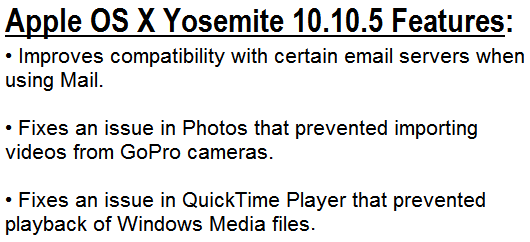
- Quicktime player download for mac yosemite mp4#
- Quicktime player download for mac yosemite install#
- Quicktime player download for mac yosemite software#
- Quicktime player download for mac yosemite download#
You can drag your video file to the open dialogue box, or otherwise navigate to it, and then open it.
Quicktime player download for mac yosemite download#
Often videos you encounter might be in MKV format, and you can use Handbrake to convert them to M4V so they can be easily dragged into a Keynote or other document, or opened with QuickTime.To do this, download Handbrake and when you open it you will be presented with a dialogue for selecting a video file of choice.
Quicktime player download for mac yosemite mp4#
To do this, you can try a number of transcoders, but a free and robust one that I recommend is Handbrake, which can read many input file formats and then output them as an MP4 (M4V) or MKV format. While third-party media players are convenient, sometimes you might need to embed a video in a Keynote presentation or otherwise use it in ways where a third-party media player might be a touch cumbersome. Note that support ended for all releases listed below and hence they won't receive any further updates. (in the picture) From there you can select.

To open ALL files by that type: Use the Get Info option. (Not sure what type of media files you are trying to open) So here is what I did: Right click or ctrl+click on the media file Open with VLC The file opened just fine. I just tested a m4v file with VLC Version 2.2.1 and it works fine. Had you downloaded it during its availability, then you can sign into the Mac App Store, press the option key, and click the Purchased tab. If you never deliberately downloaded Yosemite when it was available from the Mac App Store, and before El Capitan was released, then you are out of luck, as it is no longer available. In the menu options on the left hand side, select the Input/Codecs options. This will give you the option to change many of the options in VLC. In the options that comes up select the ‘Show All’ button at the bottom of the preference pane.
Quicktime player download for mac yosemite software#
If Apple has released a newer version of the QuickTime player, the window displays the message “Apple Software updates are available for your computer.To do this open up VLC and select the preferences under VLC Preferences. Open the downloaded file quicktimeinstaller.exe.Ĭlick the “Help” pull-down menu at the top of the QuickTime Player window, and select “Update Existing Software.” A new window appears.Visit the QuickTime download page and select Download Now.How do I record my Mac screen without QuickTime? Right-click the MOV file in the finder, select Open With, and there is a list of other installed apps that your Mac suggests to using to open the file. Once the file has downloaded all you need to do is double click on the file which will be called, QuickTimePlayer7.Ĭheck Your Video Player If QuickTime failed to play MOV file on Mac, try using other video player apps, such as VLC media player, 5KPlayer, MPlayer.
Quicktime player download for mac yosemite install#
To do this, click the Magnifying glass in the upper right hand corner of your screen and type QuickTime to see if it finds it.Ĭorrespondingly, how do I install QuickTime on my Mac? To install QuickTime on a Mac you should download the newest version of QuickTime Download (which at the time of writing is QuickTime Player 7 Version 7.6. I would try using Spotlight to search for it. Similarly, why can’t I find QuickTime on my Mac? QuickTime is located in the Applications folder unless it has been moved. (One way to get to your Applications folder is to click on the Finder icon on the Dock and then click on the Go menu and select Applications.) Click the Done button to dismiss the window that appears. Likewise, how do I enable QuickTime Player on my Mac? Go to your Applications folder and double-click QuickTime Player to open it.

You can find QuickTime Player by going to the Applications folder located on the dock of the Mac you are using.




 0 kommentar(er)
0 kommentar(er)
